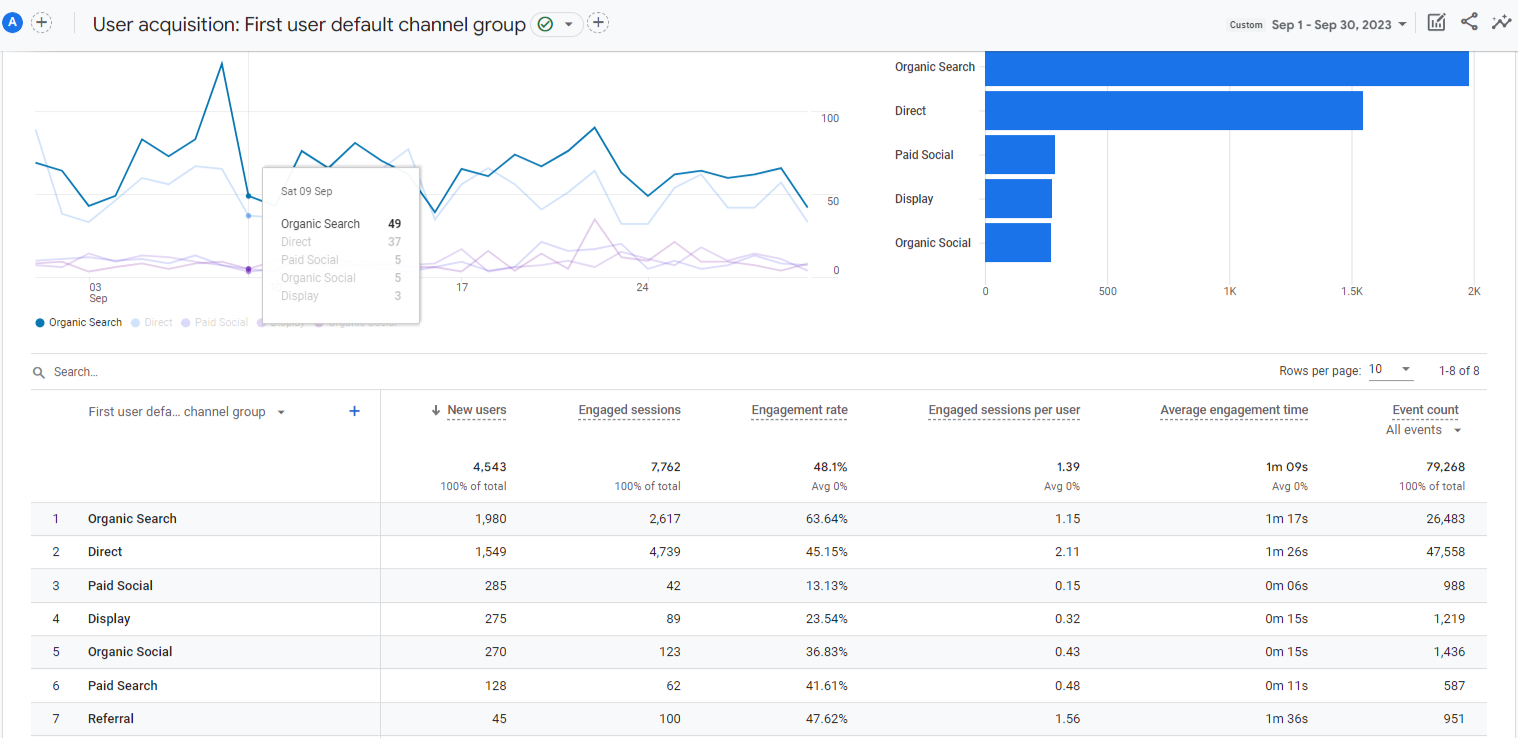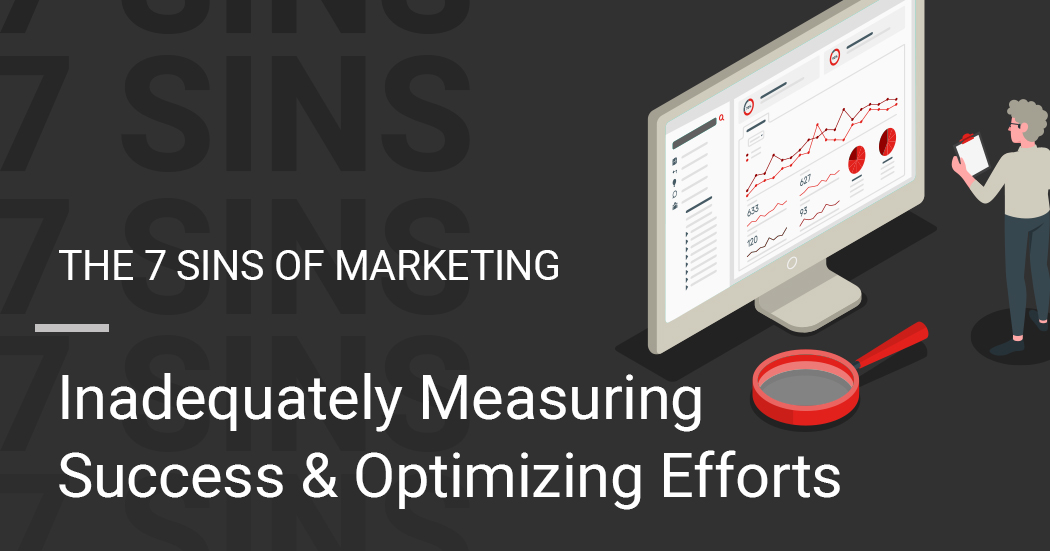Inadequately Measuring Success & Optimizing Efforts
Do you regularly measure your marketing efforts? According to MarketingWeek, most marketers claim to only measure effectiveness on an ad hoc basis, with just 13% of brands investing in ongoing tracking. If you want data and insights on what is working well, areas for improvement, and other valuable information about your customers, tracking and measuring your marketing efforts is vital.
Before you can start tracking data, you must ask yourself questions and determine exactly what information you want and need to gather. For example, maybe you see there is traffic coming to your website, but you want to know what brought people there. Or, you could be running a paid Facebook campaign and want to know what the users are doing after they click on your ad. Strategically thinking about the data you want to collect will ensure your tracking efforts are set up properly and will provide you with useful information.
When it comes to tracking data and measuring success, there are a variety of data collection paths available to help you gather insights, guide future optimizations, and set marketing goals. To help you adequately measure your marketing and optimize your current efforts, we are digging deeper into digital and traditional tracking methods and ways to interpret statistics. Keep reading to learn more!
Digital/Online Tracking Efforts
Google Analytics 4
In today’s digital era, most marketing campaigns have components (i.e., social media ads, digital newsletters, etc.) that direct back to your company’s website or a designated landing page. Because the website or landing page serves as the hub for the campaign, tracking these channels will be critical and can be done using Google Analytics 4 (GA4).
 Google sunset their Universal Analytics (UA) this past summer, and as of July 1, 2023, the primary data collection source became GA4. The new tool is designed for the future of measurement and collects both website and app data to better understand the customer journey, according to Google. GA4 can offer you a depth of information on your marketing efforts, but to get the right campaign data, you need to first set up Urchin Tracking Module (UTM) parameters and tracking links. Establishing tracking links will allow you to view your marketing campaigns separately in GA4 and pinpoint which specific efforts yield the best results. Tracking links tag five primary dimensions onto any URL, including the campaign, source, medium, content, and term.
Google sunset their Universal Analytics (UA) this past summer, and as of July 1, 2023, the primary data collection source became GA4. The new tool is designed for the future of measurement and collects both website and app data to better understand the customer journey, according to Google. GA4 can offer you a depth of information on your marketing efforts, but to get the right campaign data, you need to first set up Urchin Tracking Module (UTM) parameters and tracking links. Establishing tracking links will allow you to view your marketing campaigns separately in GA4 and pinpoint which specific efforts yield the best results. Tracking links tag five primary dimensions onto any URL, including the campaign, source, medium, content, and term.
Let’s look at an example. If you want to run a recruitment campaign on LinkedIn for marketing job applications, the UTM parameters you could use are listed below.
- Campaign = Recruitment 2023
- Source = LinkedIn
- Medium = Paid Social
- Content = Marketing Carousel Ad
The final UTM parameter, which would be added to the end of the URL, would look like this.
/?utm_campaign=recruitment-2023&utm_source=linkedin&utm_medium=paid-social&utm_content=marketing-carousel-ad
When running a campaign, like the example above, it will be important to monitor key performance indicators such as clicks, impressions, cost-per-click (CPC), and cost-per-thousand (CPM). To dig deeper, if you want to see which ad formats or variations are resulting in the most conversions, set up conversion tracking. If you apply UTM parameters for each variation, you can use GA4 to see which variations are resulting in conversions or which are resulting in the most engagement on your website via the content tag that is utilized.
To learn more about Google Analytics tracking links, check out our blog How To Set Up Google Analytics Tracking Links.
Other Tracking Tools to Consider
Many platforms, like Facebook and LinkedIn, offer their own reporting resources for both paid and organic social media marketing. Using these tools to access in-platform dashboards that house key data and analytics can be beneficial. Through Facebook’s Meta Business Suite and LinkedIn’s analytics tool, users can see organic social media reports. Data such as post reach, post engagement, impressions, new followers, top content, and audience demographic insights are available for review and can be leveraged to enhance your existing content strategy and future posts.
If your focus is on paid social, Meta Ads Manager and LinkedIn Campaign Manager offer analytics that provide insights on each ad, such as reach, impressions, cost-per-click, demographic information, and more. In addition to collecting data, Meta Ads can be used to test and optimize your marketing content. For example, if you use multiple headlines and subheadlines within your ads, the platform will tell you which performed best. You can then take those top-performing headlines and subheadlines and apply them to other content such as e-newsletters, landing pages, and more.
It is important to remember that these in-platform tools are set up to capture both organic and paid data. Ensuring you are tapping into the right metrics and dashboards for the type of content you post is important to gathering the information that is most valuable.
Customer Data You Didn’t Know Was at Your Fingertips
Reporting platforms can be robust and offer insights you may not realize you even have access to, including customer data. Check out the list below to see the data you can collect to help better understand your customers and their interactions with your marketing materials.
It is important to note that the following insights cannot be measured all on one platform. Using multiple tools (i.e., GA4 and Meta Ads Manager) in conjunction with one another will be required.
- Customer Demographics: Unlock information about your customers including their age, race, ethnicity, gender, income level, job title, and more.
- Location: Pinpoint where your customers are located, including cities, states, and regions.
- Devices: Using GA4, you can determine what type of device your customers are using, including mobile devices versus desktop computers.
- Time on Page: See how long visitors are spending on your website and specific pages (i.e., blogs, projects, etc.).
- Other Online Activity: Determine what other pages on your website visitors are viewing and other actions they are taking while online.
- Language: Gain insights into your audience’s preferred language.
- And more!
By gathering information on your customers, you can better understand who your ideal target audience is. With these insights, you can optimize future marketing efforts, including blogs, social media ads, newsletters, and other communication materials to ensure you are reaching your intended target audience with the right message, through the right channels, and at the right time.
Traditional/Offline Tracking Efforts
While the marketing landscape is digital-focused, it is important to also tap into traditional or offline tracking efforts to measure the success of your marketing tactics. Compiling insights gained through digital tracking tools and traditional methods can provide you with a well-rounded, clear picture of how your efforts are performing overall.
Asking for and gathering direct feedback from current customers can be valuable, and there are a few ways this data can be collected, including surveys, focus groups, and media mentions.
Surveys
Using an online survey is one of the easiest ways to hear what your customers have to say. Platforms such as SurveyMonkey and Qualtrics allow you to develop multiple choice and open-ended questions and distribute the piece to a sample of individuals.
Based on your specific goals for the survey and the information you are hoping to uncover, you should dial in your questions to focus on specific marketing campaigns or efforts to ensure the insights you gather can be used to optimize your future tactics.
Focus Groups
Focus groups are conducted with 3 to 12 participants and dig deeper into a specific subject matter. Because focus groups are discussion-based, they help gain in-depth insights into the participants’ thoughts and opinions. After conducting a survey, you could consider hosting focus groups to follow up on key findings that were revealed during the survey. Additionally, focus groups can be used to pre-test marketing messages, new logos, products, and more to get feedback and fine-tune the material before it is distributed to a larger group.
Media Mentions
Being aware of conversations happening on and offline about your brand can provide insights into your target audiences’ perceptions. It is recommended that you set up Google Alerts or use a paid media monitoring service, such as Cision, Meltwater, or Mention to track mentions of your company within newspapers, magazines, and other publications. Additionally, paying attention to what your customers are saying about you in social media comments, via online reviews, and more can provide information about how your marketing efforts are performing and areas for improvement to better serve your customers.
Getting your customers’ thoughts and opinions on your current marketing efforts can help you fine-tune different elements such as messaging, communication channels, visuals, and more to ensure you are providing your target audience with information that resonates with them and provides value.
Considerations for Optimizing Your Efforts
Once the data starts rolling in and you understand how to evaluate the information, you must be willing to try different things to optimize your efforts. A/B testing is just one way to gather insights that can help guide optimizations. For example, if you want to know which Facebook ad copy variation drives the most results, consider conducting A/B testing. This would involve writing two or more variations of ad copy, which would then be shown to different members of your target audience. Using the data collected through Meta Ads Manager, you can see which version performed best. Leveraging those insights in the future to create similar ad copy will boost engagement and improve your efforts.
Testing different efforts is key to gathering information that can help you optimize your future marketing initiatives. While split testing applies to both digital and traditional marketing efforts, it is much more budget-friendly to conduct the research online (i.e., testing content in an e-newsletter versus a print newsletter).
When optimizing your marketing efforts, it is also important to take a step back and compare data overtime. Doing so can help you understand seasonal behaviors and trends as well as identify the best times to launch new campaigns, special offers, and more.
Having an in-depth understanding of where your marketing efforts currently stand and doing research and testing to uncover how you can optimize your content to drive results and engage your intended target audience moving forward is essential.
Need Help Tracking & Optimizing Your Marketing Efforts?
Successfully measuring the success of your marketing efforts requires you to track the right metrics and use the proper tools. Getting it right can give you access to in-depth data and analytics to take your marketing efforts to the next level and ensure you are providing your customers with valuable information.
As a full-service marketing communications agency based in York, Pennsylvania, we have the experience and industry insights to help you set up customized tracking dashboards and provide insights on the analytics to ensure all your marketing efforts are effective and drive value for your company. If you are searching for a digital marketing partner who can help you maximize results, get in touch with our team to learn more about our services and how we can support your next project.
To read previous blogs in this series, click here.
